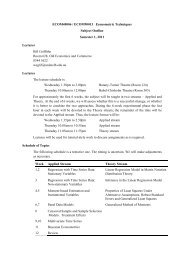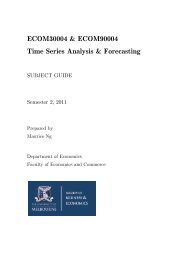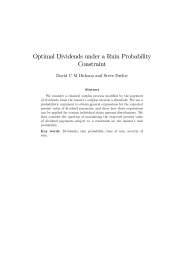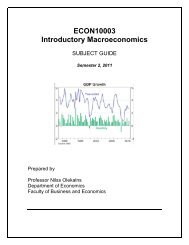A Model of Optimal Corporate Bailouts - Faculty of Business and ...
A Model of Optimal Corporate Bailouts - Faculty of Business and ...
A Model of Optimal Corporate Bailouts - Faculty of Business and ...
Create successful ePaper yourself
Turn your PDF publications into a flip-book with our unique Google optimized e-Paper software.
which implies effort <strong>of</strong> e ∗ 1 ( w 1 ) = w 1 /c − R 2 /(8·c 2 ). Comparing this expression with the effort inSection 2.2.1 (where the incumbent is fired) shows the moral hazard that managerial retentionin a restart induces. If the manager knows that she, too, will receive a second chance if thefirst-period effort fails, she has an incentive to withhold R 2 /(8·c 2 ) first-period effort at everywage level.Anticipating the effort given wage, the firm maximizesΠ| F F=RETAIN= e ∗ ( w 1 1 )·(R − w 1 ) + [1 − e ∗ ( w 1 1 )]·π ∗ ( 0, 0 ) − I 2 1= w1c − R2·(R − w8·c 2 1 ) + 1 − w 1c + R2 R2·8·c 2 4·c − I 2 − I 1 ,which implies a pr<strong>of</strong>it-maximizing wage <strong>of</strong> w ∗ 1 = R + I 2 /2 − R 2 /(16·c) > 0. Given this wage,the optimal managerial effort ise ∗ 1 = R + I 22·c− 3·R216·c 2 ,yielding maximized pr<strong>of</strong>its <strong>of</strong> Π| F F=RETAIN( e ∗ ) (Appendix equation A.2). Note that first-period1wages are higher here than in the case where the incumbent is fired, reflecting the firm’sattempt to dampen managerial moral hazard with higher wages. Nevertheless, the higher wageonly helps somewhat—first-period managerial effort remains lower than when the manager isfired.Comparing subcases 2 <strong>and</strong> 3 yields the following lemma:Lemma 1 If the incumbent <strong>and</strong> replacement are equally productive, in the absence <strong>of</strong> governmentintervention, the firm should replace the incumbent manager whenever it restarts the project.(In Section 4.1, we consider cases in which the incumbant is more productive than the potentialreplacement.) Lemma 1 establishes the optimality <strong>of</strong> firing the manager after a first-periodfailure in the absence <strong>of</strong> government intervention. This is the case even though we do notassume that the firm learns about managerial (lack <strong>of</strong>) ability from the first-period failure.Intuitively, the credible threat to fire the manager induces greater managerial effort (<strong>and</strong> lessmoral hazard) in the first period, because the manager correctly perceives that she has onlyone chance to succeed. As long as a replacement manager is equally efficient (e.g., faces thesame marginal effort costs), then the firm’s second period pay<strong>of</strong>fs are the same regardless <strong>of</strong>whether it is managed by the incumbent manager or her replacement.Thus, when restarts are pr<strong>of</strong>itable <strong>and</strong> the government does not intervene, the firm alwaysfires the incumbent upon a restart, <strong>and</strong> the firm’s initial investment decision isρ ∗ = IN if Π| F F=FIRE( e ∗ ) ≥ 0 , 1.1OUT otherwise .As already mentioned, equal efficiency <strong>of</strong> managerial replacements sidesteps any time consistency(commitment) problems by the firm (<strong>and</strong> later the government). Given that the original16
















